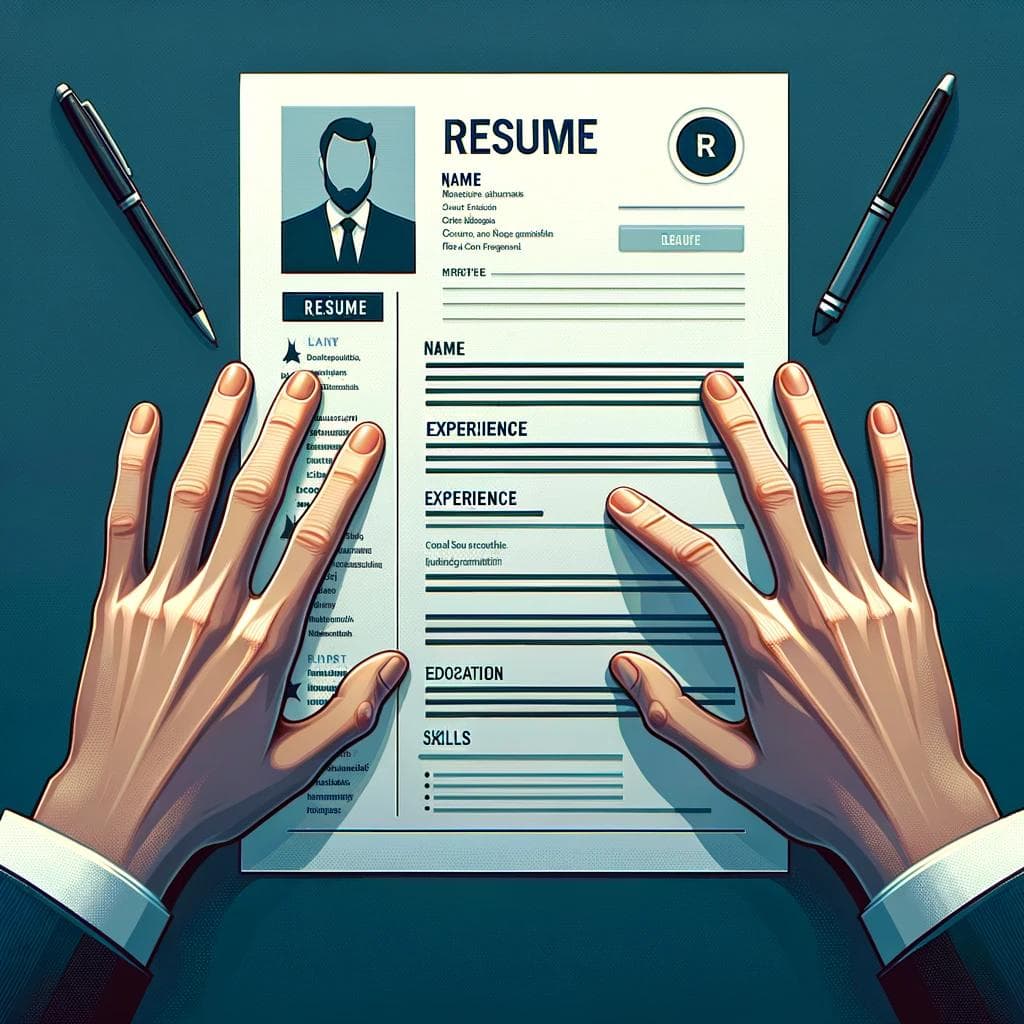Are you a recent graduate, an intern, or someone looking for new opportunities and struggling to figure out how to write a suitable resume?Do you face challenges in making your profile stand out to employers among the thousands of other job applications?Despite putting considerable effort into crafting your resume and sending it to numerous companies, are you still not receiving any responses?Mastering the art of creating an outstanding resume, as discussed in today's blog post, is not too difficult if you genuinely care about making yourself stand out and securing a quick interview from potential employers.Creating a resume is like going on a crazy rollercoaster ride in your job search journey – super exciting with tons of new opportunities but also kind of nerve-wracking. The whole process has its ups and downs, and everyone goes through moments of uncertainty. Writing your resume is a really important and kind of overwhelming first step. You want to make a killer impression, which leads to endless overthinking of every word and skill you choose. While tools such as ChatGPT and Resume Builder can assist you in generating an initial draft, the real magic of your resume is all you need to refine and perfect it. On average, employers only spend a quick 7.4 seconds checking out a resume. This super short time is because there are so many people applying for certain jobs. Hiring managers gotta quickly figure out if candidates have the right skills and experience they need.In that quick glance, hiring managers and recruiters also gotta weed out folks who won’t fit the job. They’re looking for people who are genuinely interested and can show off their passion and qualifications. Plus, if they’re using an applicant tracking system, they’re filtering resumes based on keywords and specific skills. So, candidates gotta navigate both the system and the human review.Making a good resume means matching your qualifications to the job description and using the same lingo as the company. A generic, one-size-fits-all resume isn’t gonna cut it. Putting in the extra effort to personalize each application can really up your chances of landing that dream job and ending your job search.
On average, employers only spend a quick 7.4 seconds checking out a resume. This super short time is because there are so many people applying for certain jobs. Hiring managers gotta quickly figure out if candidates have the right skills and experience they need.In that quick glance, hiring managers and recruiters also gotta weed out folks who won’t fit the job. They’re looking for people who are genuinely interested and can show off their passion and qualifications. Plus, if they’re using an applicant tracking system, they’re filtering resumes based on keywords and specific skills. So, candidates gotta navigate both the system and the human review.Making a good resume means matching your qualifications to the job description and using the same lingo as the company. A generic, one-size-fits-all resume isn’t gonna cut it. Putting in the extra effort to personalize each application can really up your chances of landing that dream job and ending your job search. When you apply for a job and don’t receive a response, you can confidently assess whether it’s due to your resume, the job market, or other factors. If you’re not getting the desired responses, it’s crucial to thoroughly review the essential elements of a powerful resume. By making strategic adjustments, you can significantly enhance your prospects of receiving more favorable outcomes.
When you apply for a job and don’t receive a response, you can confidently assess whether it’s due to your resume, the job market, or other factors. If you’re not getting the desired responses, it’s crucial to thoroughly review the essential elements of a powerful resume. By making strategic adjustments, you can significantly enhance your prospects of receiving more favorable outcomes. Now that you're well-equipped with the knowledge and understanding of how to craft a compelling resume, it's time to put these effective strategies into action. Remember, your resume is your ticket to the job interview, and you will want it to truly stand out in the crowded job market. Actually, if you implement and follow the strategies and key takeaways meticulously outlined in this blog post and put them into action, you'll definitely get bombarded with interview invites.But wait, there’s more! To truly excel in your job search journey, consider these additional tips.”
Now that you're well-equipped with the knowledge and understanding of how to craft a compelling resume, it's time to put these effective strategies into action. Remember, your resume is your ticket to the job interview, and you will want it to truly stand out in the crowded job market. Actually, if you implement and follow the strategies and key takeaways meticulously outlined in this blog post and put them into action, you'll definitely get bombarded with interview invites.But wait, there’s more! To truly excel in your job search journey, consider these additional tips.”
The Significance of an Exceptional Resume

How to Write a Resume
The blank page can be intimidating, but starting with headings and sections can help you create a great resume. Outlining the sections beforehand makes it easier to fill the page. Here are the sections you should include:1. Work ExperienceIn this section, clearly label your work experience and use separate points for each job entry. Include jobs that highlight your suitability for the role.Include any relevant experience, even if it may not seem obvious. For example, if you’re changing careers from product engineer to project manager, showcase transferable soft skills. Make sure to provide a description or bullet points that demonstrate the connection.Each entry should include:- Job title
- Organization Name
- Dates of employment
- Brief description of accomplishments
Creating a Killer Resume That Could Get You 2x More Interviews

#1: Simplify your Resume
To ensure efficient sorting of resumes within a limited time frame, it is highly advantageous to utilize uncomplicated formatting techniques, concise sentence structures, bullet points for presenting information, an appropriate font selection, and avoiding clichés. Here are some suggestions:- Prominent Section Headers: One effective method is to make section titles such as "Education," "Experience," and "Skills" stand out by implementing a larger font size and/or a distinct color. This allows recruiters to swiftly locate the necessary information without wasting precious time.
- Concise Bullet Points: Instead of composing lengthy paragraphs, it is recommended to present information in brief yet impactful points. Each bullet point should ideally be limited to 1-2 lines for optimal readability. Recruiters typically do not have the luxury of time to thoroughly read lengthy blocks of text.
- Appropriate Font Selection: Opting for a clean and easily readable font, such as Calibri or Arial, is highly advisable. Maintaining a font size between 11-12 ensures easy legibility, avoiding anything smaller than 10. It is essential to ensure that both human readers and automated systems can effortlessly interpret the chosen font.
- Strategic Use of Whitespace: It is crucial to avoid overcrowding the resume with an excessive amount of text. Leaving some empty space enhances the visual appeal and reduces the overall clutter, making the document more visually appealing and easier to navigate.
- Create a clean, simply formatted, and easy-to-read resume that clearly demonstrates your qualifications for the role you're applying to.
- Refer to number one.
- Seriously, it's just number one.
#2: Crafting an Engaging Summary that Hooks Recruiters' Attention
A resume summary, also known as an objective, is a concise paragraph of 3-5 sentences that expands on your headline statement and highlights why you are a strong candidate for the job. It is beneficial for both experienced professionals and those with no prior experience. Think of the summary section as a well-crafted, cold email that captures the reader's attention. By researching the recipient and creating an engaging and concise summary, you increase the chances of getting a response.When done effectively, the summary section can help align your skills and experience with the position. While some may argue that it takes up too much space or lacks usefulness, it is still crucial to recognize that recruiters want to learn more about you beyond the experience section. Therefore, it is important to take the time to thoroughly understand the company you are applying to and showcase what matters to them in your summary. This approach not only makes your resume more memorable but also shapes the recruiter's perception of you in a positive light.Furthermore, the summary section holds immense value when it comes to switching careers, lacking work experience for internships, or having gaps in your work history. Recruiters naturally have questions when they see such gaps or changes, such as why the career switch and if you have sufficient experience. To proactively address these questions and alleviate any concerns, utilize your summary section to provide insights into why you took a career break, what you gained during that time, why you want to switch companies or need the internship position, and how you improved and studied during any gaps. Mastering the summary section brings you closer to creating a standout resume. Now, it's time to understand how to connect your responsibilities with results and effectively present your work achievements.Small tips for nailing your summary section:- Don't mention information you already have on your resume
- Make sure to highlight your critical skills relevant to the job using keywords from the job description.
- Craft a concise summary statement that effectively demonstrates why you are the ideal candidate for the position.
- Showcase your notable achievements that you aim to replicate in your new role.
- Provide concrete evidence of your accomplishments by incorporating specific metrics such as percentages, sales figures, and other measurable results that provide a realistic perspective of your professional achievements.
# 3: Resumes Should Be Relevant
Studies have shown that 61% of recruiters will toss out a resume that hasn’t been customized for the specific job. So, if you want your resume to pack a punch, it’s gotta be tailor-made for the position you’re gunning for. When you personalize your resume, you’re forging a link between your experience and what the employer is after. So, don’t forget to sprinkle in the job title you’re targeting, shine a light on those oh-so-relevant skills, and give your accomplishments the spotlight they deserve. Trust me, it can make a world of difference!Another big thing is work experience. Like, more than 90% of recruiters really wanna see relevant experience on a resume. So, if you customize your resume for the specific job you’re going for, you’re giving the recruiters the deets they need to know that you’re a perfect match.Customizing your resume doesn’t have to be a drag. It can be as easy as throwing in a few tweaks and tweaks. By tailoring your resume for each gig you go for, you’ll up your chances of snagging some sweet outcomes.Key Takeaway: If you want to boost your chances of nailing the job, make sure to personalize your resume to match the position you’re gunning for.# 4: Resumes Should Include Keywords Specific to the Industry
Using industry-specific words in your resume is super important because it helps employers figure out if you have the necessary skills, abilities, and qualifications for the job. To up your chances of getting interviews, do some research on the professional, technical, and academic skills needed for the position and give them top priority on your resume.Keywords are essential not only for the fancy applicant tracking software (ATS) to filter out resumes but also for the human reviewers. Once your resume passes the ATS screening, the HR person checking it out will want to see the relevant keywords right away without having to search for them.To make it easy for hiring managers to find the info they need, I suggest adding a special section just for keywords or keyword competencies at the very top of your resume. That way, you can immediately show off your professional, academic, and technical skills.By making it easier for the hiring manager to make a decision, you’ll increase your chances of getting more interview requests. Pretty neat, right?# 5: Resumes Got to Show Results
Recruiters often say that finding skilled candidates is the biggest challenge when hiring. But the truth is, there are actually plenty of skilled candidates out there. The problem is that they have a hard time showing off their accomplishments and what they can do. The secret to a killer resume is to show off your value and what you’ve achieved. Hiring managers want to see what you’ve done in the past to gauge how well you’ll perform in the future. So it’s super important to clearly explain what you’ve already achieved.Alright, so here’s a cool trick you can use: the C.A.R. format, which stands for Challenge, Action, and Result. Basically, for each job you’ve had, talk about the challenge you faced, what you did to deal with it, and what happened as a result. Check out this example of a resume bullet written in this format:- Achieved a 20% increase in customer satisfaction scores through the implementation of a new customer support system. This was accomplished by streamlining processes, training support staff on new procedures, and implementing a feedback loop for continuous improvement.
# 6: Personal Branding is Essential in Resumes
Alright, so personal branding is all about finding and highlighting the things that make you special and awesome to hiring managers. If you want to build a killer personal brand for your resume, take a moment to think about these questions:- What sets you apart from others in your field?
- So, what sets your approach apart from the rest?
- How do people usually describe your strengths when they introduce you to others?
- What do people usually come to you for help or advice with?
- What achievements are you most proud of?
#7 Seek an Objective Perspective and Leverage Technology
To enhance the quality of your resume, it can be highly advantageous to seek the perspectives of others and leverage cutting-edge technology. It is recommended to reach out to trustworthy individuals, such as coworkers or colleagues, and request their sincere feedback. Their valuable input can extend beyond mere validation and offer constructive criticism to help you refine your resume. Incorporating their insights can significantly contribute to the development of a compelling resume while also ensuring there are no inadvertent errors or omissions.Furthermore, it is worth exploring the potential of AI technology, such as the revolutionary platform called RapidResume. This innovative tool utilizes advanced AI algorithms to swiftly optimize your resume, resulting in an exceptional document with minimal exertion. With features like the "rate my resume" function and more, you can promptly receive an evaluation and score, gaining invaluable insights to further enhance your resume. For more information about this remarkable AI Resume Builder, click here.Wrapping up

- Networking Matters: Don’t underestimate the power of networking. Connect with professionals in your industry through LinkedIn, attend industry events, and engage in meaningful conversations. Networking can open doors to opportunities that might not be advertised.
- Continuous Learning: Show your dedication to growth by highlighting any ongoing education or relevant courses you’re taking. This not only demonstrates your commitment to staying updated in your field but also adds value to your resume.
